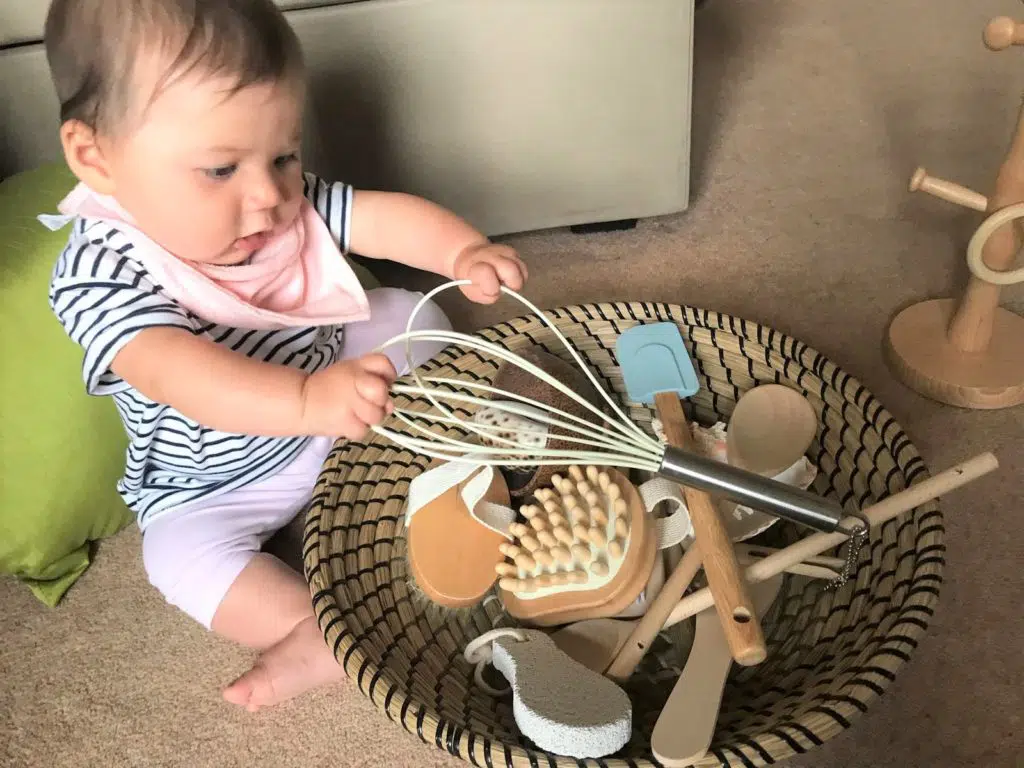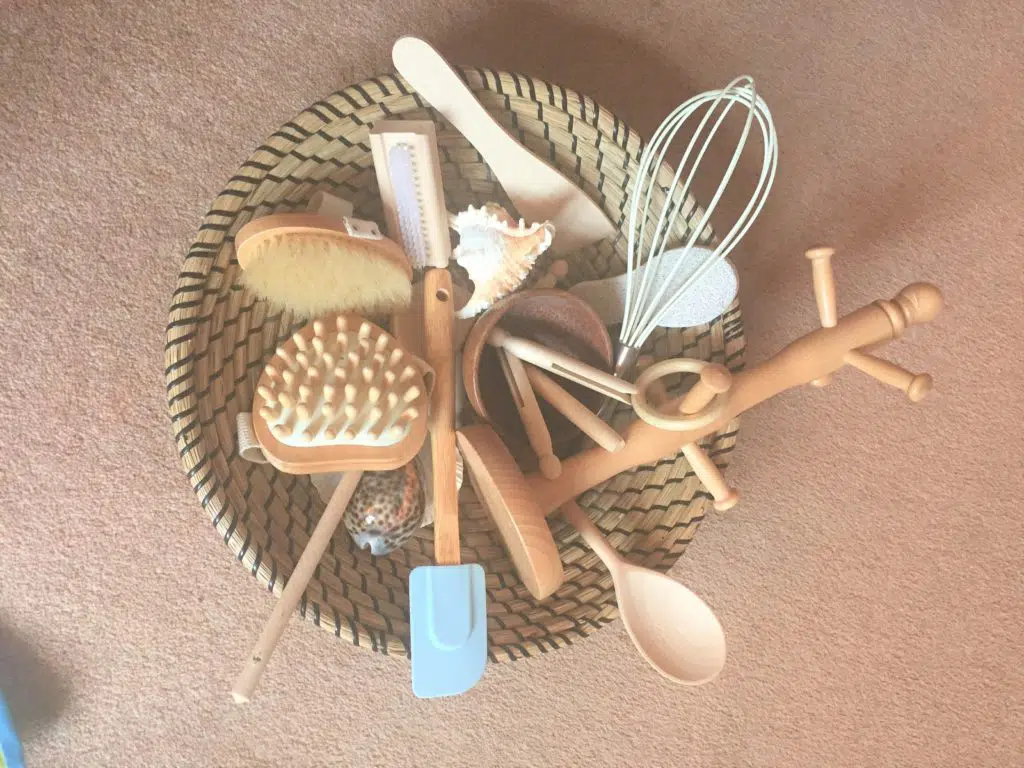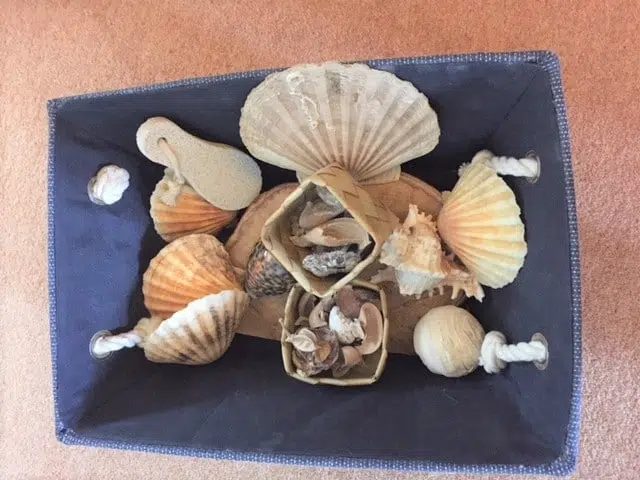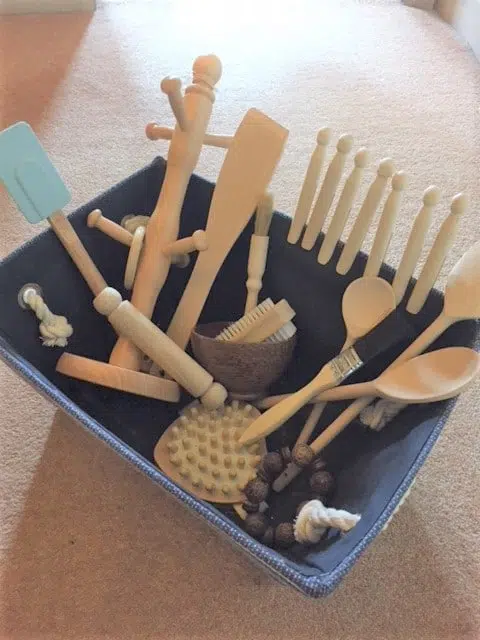Something amazing is going on in the world of early education at the moment. Teachers are beginning to realize the true value of their children playing with natural and authentic resources.
And it doesn’t come any more natural than treasure baskets!
Treasure baskets are shallow baskets that are usually made of wicker. They are filled with a variety of random objects, that are selected for the ability to stimulate the curiosity of the young child that is interacting with them.
Treasure baskets offer one of the deepest forms of play to young children. In this post, I’ll show you exactly what they are, how to create one, how to get the most out of them, and lots and lots of treasure basket ideas that you can try!

Treasure Baskets Offer Deep Learning
I’ve observed toddlers at play many times when I’ve visited childcare settings. An enticing treasure basket full of natural real-life objects will provide lots of opportunities to learn about their world and usually keeps them occupied for twice as long as a pre-cast plastic toy.
Treasure baskets can be themed, but there are no definite rules about what you can or can’t put in them.
Make Treasure Baskets Look Attractive
Try to make your basket look as interesting and enticing as possible. When you are looking for items to put in them, think about:
Exciting Textures
Toddlers love to handle different materials and textures. Everything is new and exciting to them.
They will want to mouth the objects and feel them, so make sure that you consider the safety aspect of this when you are putting a treasure basket together.
Think about contrasting materials like metal, wood, rubber, silk, and wool.
Contrasting Colors
We want to make our treasure baskets as enticing to children as we possibly can. Thinking about colors can help us to do this, but that doesn’t mean the basket has to be full of unnatural, acrylic colors.
A basket of natural resources can still have different shades and beautiful muted colors, like a dried orange or a striped seed pod.
Consider adding a beautiful piece of material, or a real flower.
Various Shapes
We want our toddlers to learn about their world in a natural way. Supporting their play as they explore real-life objects such as a wooden rolling pin, a bunch of different-sized keys, and a selection of different round lids will give us plenty of opportunities to talk about different shapes and sizes in a natural way.
Children are much more likely to remember the names of shapes in a real-life context than by looking at flashcards.

Unnatural Vs Natural Experiences
Over the past century, children’s toys have become more and more unnatural.
By unnatural, I mean that they are increasingly likely to be made from plastic, or they include some electronic component, or most likely, both.
Yet, if you watch a baby or toddler play for a sustained amount of time, given the choice, children are generally more naturally drawn to real-life, natural resources.
Think of that child at Christmas who opens a beautiful pre-cast plastic castle, but seems to have much more fun playing with the cardboard box and the paper it was wrapped in.
Consider that expensive, plastic Wendy house in the garden that the children rarely go in, preferring instead to scoop up handfuls of gravel, pick the flowers or jump in muddy puddles.
Children have good instincts and we should trust that inbuilt inclination to go for the natural resources as there is almost always more play value in resources that are open-ended.
Pre-cast plastic toys can only ever be what they are cast as (for example, a castle, a farm, a doll’s house, or a boat. It may have moving parts and bright colors but it can only ever be what it already is…
A large cardboard box, on the other hand, has endless possibilities. It is open-ended enough to be a spaceship, a dungeon, a giant’s castle a hiding place, or a ship, sailing out to sea.
That’s not to say that we should get rid of all plastic or electronic toys but it’s good to remember that there are many benefits to open-ended, natural resources.
They allow children to explore, find things out for themselves, and use their imaginations.
They allow them to imitate the adults around them; to copy what their parents or carers do. If you parent or care for a toddler, there are lots of things you can provide, at a minimum cost to develop your toddler’s understanding.
Here Are A Few Treasure Basket Ideas To Get Started
If you possibly can, provide a large natural wicker or hessian basket, or a box made from wood. If you haven’t got one of those, there’s no need to worry – you could use a cardboard shoe box to get started.
Try to have a theme for your treasure basket rather than using completely random objects.
Here are a few themes that I’ve seen work well with toddlers:
- Natural materials
- Shiny materials
- Different shapes.
- Beautiful colors
- Similar but different e.g. different kinds of brushes
- Cookery
- Music
- Things that blow in the wind
- The seaside
You shouldn’t need to buy many items. The idea is to use as many real-life or authentic objects as you can. I can usually fill a box by searching around my house and garden.
Pound shops and car boots sales are also brilliant for finding authentic and interesting materials at a reasonable price.
Below is a list of ideas to help inspire you. There is no need to use all the suggestions in every list, and if you have other items that you can use on the same theme, of course, add them in.
Ideas For A Treasure Basket Of Natural Materials
Small and large sea shells
Large and small pine cones
Seed pods
Pebbles, rocks, stones
Dried flowers/grasses
Dried whole orange
A wicker ball
A real sponge
A loofah
Sheep’s wool
Feathers
Corks
A selection of twigs, leaves, and ferns
An assortment of shells such as these:

Ideas For A Treasure Basket To Explore Shape
Lots of different recycled lids from jars and bottles.
Curtain hoops/rings
Sturdy cardboard tubes or discs
Polished pebbles
Wooden Dowling
Large springs (slinky)
Boxes that fit into one another
Wooden eggs and egg cups
Wooden Russian dolls
Cork coasters
Rolling pin
Wooden chopsticks
Pumice stone
Ideas For A Treasure Basket To Explore Different Materials
Polished pebbles/stones
Pieces of fabric – fur, satin, denim, cotton, wool
Silk scarves
A hot water bottle
Rubber piping
Recycled netting eg, from oranges
A net shopping bag
Wooden curtain rings
Wooden eggcups
Corks
A small feather pillow
Ideas For A Treasure Basket To Explore Contrasts
Spoons
A large wooden ladle
A metal slotted spoon
Plastic colorful spoons
A selection of teaspoons
Soup and dessert spoons
Dolls spoons
A selection of wooden spoons
A carved spoon
A wooden spatula
Measuring spoons
An ice-cream scoop
Brushes
A natural hairbrush
A wooden comb
A pastry brush
A shaving brush
A nail brush
A large wooden paintbrush
Small wooden paintbrushes
A wooden brush head with firm bristles
A soft baby’s hairbrush
A bottle brush
A Treasure Basket To Explore Properties Of Materials
Wooden egg cup
Wooden dolly pegs
A metal tin
A piece of thick chain
A metal whisk
A wooden bowl
Napkin rings
A juicer
Small glass jars (spice size)
Bean bag
Flower pots of various sizes
Cookery Treasure basket
Wooden spoon
Wooden rolling pin
A handheld whisk
Large bowl
Cake tin
Cake cases
Empty jar of honey
Empty egg box
Empty margarine/butter tub
Hard-boiled or rubber eggs
Egg cups
Teaspoon
Chopsticks
Small pan
Measuring jar

A Treasure Basket To Explore A Windy Day
A small plastic windmill
A flag
A string of bunting
Wind chimes
Feathers
Balloons
Socks and pegs
String
A small kite
A paper / Japanese fan
How Children Use Them
Babies and toddlers instinctively want to explore objects that they have seen the adults around them using.
Expect them to feel them, mouth them, roll and throw them. They are testing out the properties and learning about their senses.
You may want to leave some baskets out as part of your daily provision. I like to keep some special boxes that I bring out to keep the children’s play fresh and exciting.
Toys Vs Treasure Baskets
If you are working in daycare, you may feel pressure to provide expensive toys for your children to play with. Sometimes, we may need to explain the reasons why we are choosing to provide a treasure basket full of real-life objects in favor of an electronic all singing and dancing toy, complete with flashing lights and sounds.
That’s not to say you should never use electronic or plastic toys. They have a place and can be brilliant, but children need a balance between the two.
Here are some things you could say to help explain why you are using a treasure basket:
We are using authentic resources because children learn best from real-life experiences
Using a treasure basket provides opportunities for your child to use all of their senses.
Open-ended resources mean your child is more likely to use their imagination and be creative.
It is important for your child to discover and explore different materials with different properties.
Treasure baskets are a brilliant way to introduce a new language.
Look how engaged the children are and how much fun they are having!
The last time I demonstrated a treasure box in a Nursery, a practitioner exclaimed
“This is just like the way my Grandma used to play with me!”
Exactly it! Grandparents have always known the importance and magic of capturing a child’s attention.
When I was little, my grandma would always give us her pots, pans, and wooden spoons to play with and we would have a great time. We used them to cook in our pretend cafe, we made potions and cast spells and then turned them upside down and played the drums in our pretend band.
We were using our imaginations, being creative, learning about the world around us, trying out new ideas, and using role-play, all without costing a penny.
As well as providing the treasure baskets, it’s very important for us to sit alongside and talk about each piece of treasure so that the children are hearing new words and language as they play.
Treasure baskets give us lots of opportunities to talk to children for example:
Think of opposites:
- Heavy and light
- Big and small
- Rough and smooth
- Open and closed
- Soft and hard
- Long and short
We can introduce new concept words:
- Spinning and turning
- Rolling and sliding
- Touching and feeling
- Smelling
- Tipping
Final Thoughts
As always, keep it fun. The moment we start to “teach” children the names of colors or shapes, we are likely to lose their interest.
Instead, follow the child’s lead. Talk about the objects that they seem most interested in.
Say the names of the objects in the treasure basket naturally in conversation. Real, or authentic objects are endlessly fascinating to toddlers.
So what are you waiting for – go and find your treasure. Have fun!
